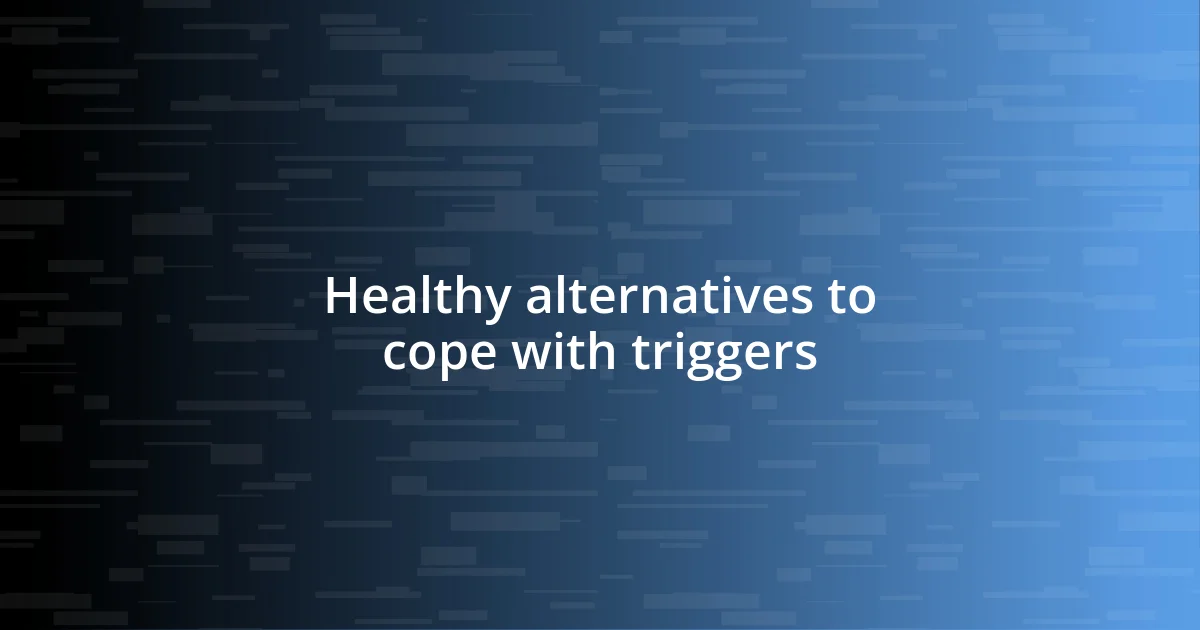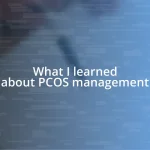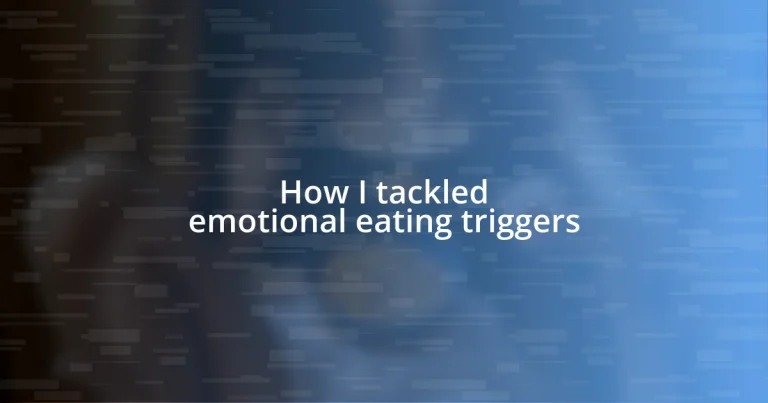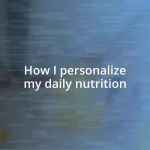Key takeaways:
- Emotional eating often stems from deeper feelings such as stress, loneliness, and boredom, highlighting the need to identify and address these triggers through self-reflection and healthier coping mechanisms.
- Practical strategies like mindfulness, physical activity, and support networks can help manage emotions and reduce the urge to use food for comfort.
- Tracking progress and celebrating small victories fosters motivation, while self-reflection on setbacks transforms them into learning opportunities for building long-term strategies for healthier eating habits.

Understanding emotional eating triggers
Understanding emotional eating triggers can feel like peeling back layers of an onion. I remember a time when stress at work would lead me straight to the fridge, seeking comfort in that familiar tub of ice cream. It’s interesting to think about how emotions can become so intertwined with our eating habits; have you ever found yourself munching mindlessly during a tense moment?
Often, emotional eating is a response to feelings rather than hunger. I once ate an entire bag of chips after an argument with a friend. In that moment, I wasn’t craving a snack; I was looking for solace. It’s fascinating to recognize that these triggers—stress, boredom, loneliness—can often mask deeper emotions that need addressing.
Sometimes, I ask myself why I turn to food instead of dealing directly with my feelings. This realization has encouraged me to explore healthier coping mechanisms. Have you considered how turning to a favorite book or a walk might provide the comfort needed instead of food? Understanding these triggers isn’t just about recognizing the patterns; it’s about finding the path to healthier emotional responses.

Identifying personal triggers effectively
Identifying personal triggers effectively involves self-reflection and keen observation. I found journaling to be a game changer in this process. By keeping track of my emotions and my eating habits, I noticed patterns start to emerge—like how I often reached for snacks during late-night TV binges, fueled by boredom rather than actual hunger.
Recognizing these triggers requires honesty with oneself. For example, one particular evening, I realized that every time I faced a deadline, I would subconsciously reach for chocolate bars, considering them my fuel. This habit didn’t just stem from a sweet tooth; it was my brain’s way of seeking a quick emotional reward amidst stress. Understanding that connection allowed me to seek healthier alternatives, like taking a quick break for a walk instead.
Utilizing a comparison table can also help clarify these emotional connections. Here’s a way to organize your thoughts around triggers:
| Trigger Type | Example Response |
|---|---|
| Stress | Reaching for sugary snacks for comfort |
| Boredom | Mindless eating while watching TV |
| Loneliness | Turning to food when feeling isolated |
| Anxiety | Overeating before an important event |

Practical strategies to manage emotions
Finding practical strategies to manage emotions has been crucial for me on this journey. One technique I’ve embraced is mindfulness meditation. I vividly recall those moments when I felt overwhelmed; instead of reaching for that tempting snack, I took a deep breath and sat quietly for a few minutes. This simple practice helped center my thoughts and allowed me to confront the emotions that were driving me to snack.
Here are some strategies I’ve found effective in managing my emotions:
- Mindful Breathing: Focusing on my breath helps alleviate stress and clarify my feelings.
- Physical Activity: Engaging in a quick workout can shift my mood and reduce the urge to eat emotionally.
- Creative Outlets: I often pick up a paintbrush or write in my journal, allowing my feelings to flow out in a healthy way.
- Support Networks: Talking to friends or family about my feelings fosters connection and diminishes the desire to seek comfort in food.
- Structured Routines: I’ve created a daily schedule that includes time for self-care, discouraging emotional eating during unstructured periods.
Understanding how these strategies interconnect with my emotions has been a journey, but it’s been incredibly empowering. The key lies in recognizing when I feel the urge to eat as an emotional response. Instead of getting lost in the cycle, I can pause and choose a different path.

Healthy alternatives to cope with triggers
When I started exploring healthy alternatives to cope with my emotional triggers, I stumbled upon the power of herbal teas. Instead of reaching for a bag of chips during stressful evenings, I found myself brewing chamomile or peppermint tea. The warmth of the cup in my hands and the soothing aroma seemed to calm my racing thoughts, almost like a cozy hug that reminded me to pause and breathe.
Switching up my snack choices also made a significant difference. Whenever boredom tried to pull me into that mindless eating pattern, I turned to fresh fruits or raw veggies. I vividly recall one afternoon when I prepared crunchy carrot sticks and hummus. The experience was refreshing and invigorating, especially when paired with my favorite podcast. Not only did it satisfy my snacking urge, but it also distracted me from the emotional depths that often accompanied my late-afternoon fatigue.
In moments of isolation, I learned to write about my feelings instead of retreating to the kitchen. One evening, after feeling particularly lonely, I sat with my journal and poured out my thoughts. It was surprising how much lighter I felt once I acknowledged those emotions on paper. I realized that my feelings were valid and deserved attention, but they didn’t have to lead me to food for comfort. In fact, writing became a therapeutic outlet that strengthened my emotional resilience. Isn’t it fascinating how a pen and paper can shift our perspective?

Creating a supportive environment
Surrounding myself with support has made a world of difference in tackling emotional eating triggers. One time, when I was feeling particularly vulnerable, I reached out to my closest friend and shared what I was going through. Just having that open conversation was like shedding a heavy coat; it reminded me that I wasn’t alone in this struggle, and it paved the way for more honest exchanges.
It’s amazing how creating a space of understanding can reduce the temptation to comfort myself with food. I’ve found that when my home is filled with encouraging reminders—like affirmations on sticky notes or even images of healthy meals—I find it easier to prioritize my emotional well-being. These small cues urge me to reflect on my feelings rather than distract myself with snacks. Have you ever noticed how the atmosphere around you can impact your mood?
Another essential aspect of my supportive environment is surrounding myself with individuals who uplift and inspire me to make healthier choices. I remember times when my partner would join me for evening walks instead of letting me sink into a couch potato routine. These moments shared over light conversation transformed our evenings into a blend of exercise and connection, steering clear of mindless late-night snacking. It’s important to realize that those who are around us can influence our habits in powerful ways, wouldn’t you agree?

Building long-term strategies for change
Building long-term strategies for change requires a commitment to understanding and addressing the root causes of emotional eating. I learned that tracking my emotional states alongside my eating habits truly opened my eyes. One memorable week, I noted that I tended to snack more when overwhelmed with work deadlines. I realized that instead of juggling stress with food, I could establish a few devoted minutes to practice mindfulness or meditation. It felt like giving myself permission to prioritize my mental health without equating it to a food reward.
I also embraced the power of meal planning to nurture healthier habits. I vividly remember an evening spent prepping meals for the week, chopping vibrant veggies and cooking warm quinoa while listening to upbeat music. This simple act transformed into a ritual that not only saved me from reaching for unhealthy options when stressed but also gave me a sense of accomplishment. Have you ever found joy in being proactive about your meals? It’s incredible how such planning can shift my focus from momentary cravings to nourishing my body for the long haul.
Finally, I realized that reinforcing my self-discipline was key to long-term change. On days when I felt the pull of emotional eating, I would take a step back to reassess my feelings. I’d ask myself, “Am I really hungry or is there something else I need right now?” Reflecting on this question made a marked difference, as it led me to alternative solutions—like calling a friend or diving into a hobby instead of reaching for that comforting snack. This practice of checking in with myself turned into a vital tool, fortifying my journey towards healthier choices. What if we all took just one minute to pause and listen to our emotions before reaching for food?

Tracking progress and staying motivated
Tracking my progress is like having a personal roadmap on this journey. I started by using a journal to jot down not only what I ate but also the feelings that accompanied those choices. One evening, I discovered that weeknight dinners often coincided with feelings of loneliness. That insight made me realize that I could swap snacks for a virtual dinner date with a friend instead. It’s fascinating how connecting with others can fill emotional voids, don’t you think?
Motivation ebbs and flows, but I’ve found that celebrating small victories keeps the fire alive. I remember the rush I felt after going an entire week without succumbing to emotional eating. I treated myself to a new book that had been on my wish list. Simple rewards like this have helped reinforce positive behavior and made me eager to keep pushing forward. Have you ever tried rewarding yourself for meeting small goals? It makes the journey feel so much more enjoyable.
It’s important to recalibrate my approach when I encounter setbacks. There were days when stress spiraled, leading me back to old habits. Instead of berating myself, I would reflect on what led me there. Understanding that a moment of indulgence didn’t erase all my progress helped me bounce back quicker. Each setback became a stepping stone rather than a stumbling block—what if we all practiced that kind of self-forgiveness? It’s a refreshing perspective that can drastically change how we view our relationship with food.














